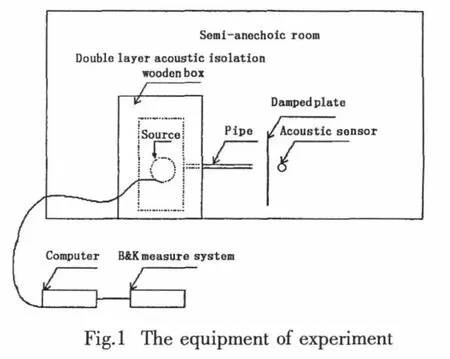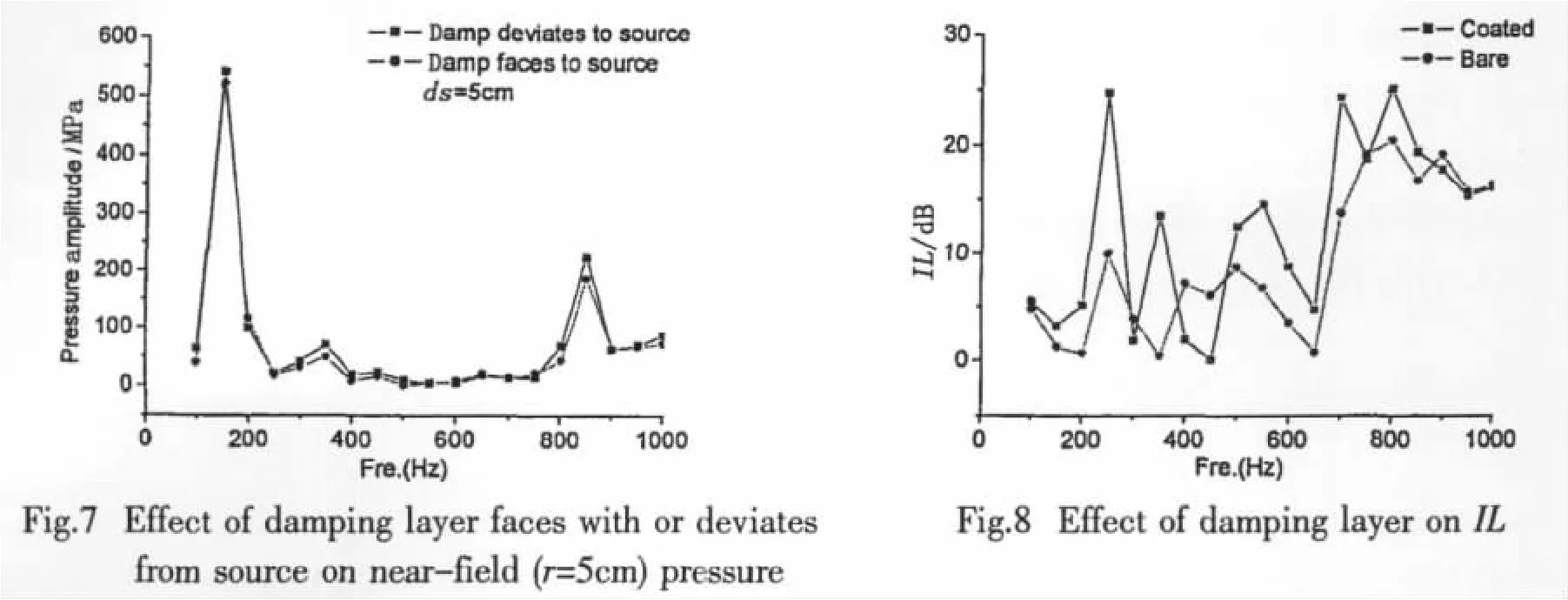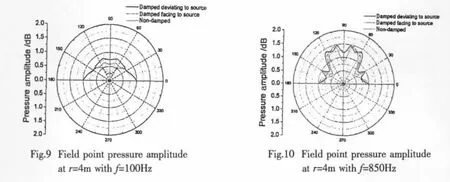Studies on Acoustic Scattering Experiment of Finite Plate in Half Space
(School of Naval Architecture Engineering,Faculty of Vehicle Engineering and Mechanics,State Key Laboratory of Structural Analysis for Industrial Equipment,Dalian University of Technology,Dalian 116024,China)
1 Introduction
The acoustic scattering of elastic structure has been a subject of considerable interest in engineering field for decades.The importance of studying the acoustic scattering lies in the fact that many physical objects can at least be approximated by one of the aforementioned geometries and material characteristic.Therefore,it is used to model many important underwater targets such as marine animals and submarines.Beranek[1]designated a chapter in his book that summarized some of the theoretical and experimental work done to study the plane wave sound field disturbance by spheres,cylinders circular disks and semi-infinite plane screens.Beranek also discussed the disturbing effect of a finite-sized baffle on the radiation pattern of a loudspeaker.In the last few decades,many other researchers have been focusing on this field.Takahi Hasegawa[2]and Rozhdestvenskii[3]and Norton[4]have developed many numerical and analytical methods to compute acoustic scattering,and some of the scattering experiments about spheroidal objects have been analyzed by Bayliss[5]and Tarawneh[6].Claudio[7]presented the theoretical model to describle the nonlinear scattering of acoustic waves by surface-breaking cracks with faces in partial contact.Stanton[8]based on the diffraction per unit length of an in-finitely long straight edge formulation described acoustical scattering in the frequency domain through use of an approximate line-integral formulation and Stanton[9]also calibrated the broadband active acoustic systems using a single standard spherical target.In the present paper,the acoustic scattering experiment of a four side free plate with acoustic beam used as the sound source in the semi-anechoic room has been made in Dalian University of Technology(DUT).The purpose of this work is to present the scattering characteristics of finite plate in half space,which helps to estimate the damping finite plate performance of sound insulation.
2 Experimental materials and methods
2.1 Experimental materials
Thin aluminum plates with length of 1m,width of 1m and thickness of 3mm are used in the experiment.The correlative physical parameters are:Elastic modulus,E1=6.89×104MPa,Poisson ratio u1=0.3,density ρ1=2 700kg/m3.Rubber is adopted to form the damping layer,which is covered on one single surface of aluminum plate and its shear modulus G2=0.896MPa,Poisson ratio u2=0.49,density ρ2=999kg/m3,and thickness is 5mm.
2.2 Experimental devices and methods
The PLUSE system of B&K Company which was made in Denmark is applied in this experiment in the Semi-anechoic Room(absorption coefficient is 0.99 and floor reflected coefficient is 0.95)as shown in Fig.1.
A spherical source is placed in the double layer wooden box and a stainless steel pipe(diameter is 0.025m)is inserted in the front of it,so that sound wave can propagate along the pipeline.In this way,an acoustic beam can be applied directly onto the surface of the plate.It can be demonstrated that the acoustic insulation capacity of the double layer box is 40 to 50dB.During the experiment,acoustic sensors are placed at the designed positions to measure the acoustic pressure.The distribution of acoustic pressure in the scattering field is obtained as the frequency is manipulated.

3 Analysis of the experimental results
3.1 The definition of the insertion loss
It is a hot topic to analyze the impact of baffle plate on sound insulation in infinite space.Generally,people definite the transmission loss[10]as below:

where tIis transmission coefficient,piis incident wave pressure,ptis transmission pressure.From the definition above,the plate should be assumed as infinity,while it is unrealistic to obtain such an infinity dimension in this experiment.In addition,the baffle plate is not in a theoretical plane wave field.Therefore,formula(1)cannot be applied into this experiment.In this paper,we define the insertion loss(IL)as:the ratio of pressure received by sensor with the finite plate to that without the finite plate,so it can be written as:

where pais acoustic pressure with a finite plate,and pbis acoustic pressure without a finite plate.
3.2 Effect of finite plate on the insertion loss
3.2.1 Effect of distance between source and finite plate on the insertion loss
During the experiment,the distance between the finite plate and sensors is constant and the incident angle of the incident wave is 90°.The distances between finite plate and acoustic source are 5cm and 10cm respectively,it is so near and the ratio of plate width and pipe diameter is 40 so that we can ignore the acoustic diffraction.
Field-point(at the back of plate r=5cm)pressure curve when damping faces with source is shown in Fig.2,and the corresponding insertion loss is shown in Fig.3,where ‘ds’ is the distance between source and finite plate.It can be concluded that in the near field the total pressure will decrease as the distance between acoustic source and finite plate increases.The closer the finite plate to acoustic source,the greater the changes of the inserted loss will be.For example,when the finite plate is 5cm away from acoustic source,the insertion loss is varying from 0 to 25dB.In contrast,the insertion loss is smaller(varying from 2-19dB)when the finite plate is 10cm away from the source.So it presents that the finite plate has a better acoustic insulation capacity on noise source near to it.

Compared Fig.4 and Fig.5,it can be presented that no matter the damping layer faces with source or not,the distance between acoustic source and finite plate has no influence on acoustic pressure in the field(r=2m).The acoustic pressure has no obvious change as the frequency increases.The fluctuations in Fig.4 and Fig.5 are due to the finite plate which is subject to resonance with sound frequency.

3.2.2 Effect of finite plate thickness on the insertion loss

The effect of finite plate thickness on IL is shown in Fig.6.Generally speaking,the insertion loss will be greater with the increase of the thickness of the finite plate,but the change of pressure amplitude is faint,it is indicated that the insertion loss is not sensitive to the thickness of the finite plate.
3.2.3 Effect of damping layer on the insertion loss
In order to discuss the influence of damping layer on the scattering field,three circumstances,including damping layer facing with acoustic source,damping layer deviating from acoustic source and non-damping layer plate facing with acoustic source are considered.
Fig.7 shows the effect of the damped layer faces with the acoustic source on the total acoustic pressure in the near field.It can be seen that the acoustic pressure made by damping layer deviating from source is higher than the damping layer facing with source.It can be explained that the damped layer will absorb more energy that makes the transmission pressure reduce when it faces with source.Due to the decay of sound wave,the difference pressure between damping layer facing with the source and damping layer deviating from the source will be faint in the far field.
The insertion losses affected by damping plate and non-damping plate are shown in Fig.8.The result suggests that the insertion loss of the damping plate is generally greater than nondamping plate when the source position is constant.It can be explained that most of energy is absorbed by damping layer and it enhances the acoustic insulation capacity,especially for the point of the plate natural frequency.For example,when acoustic frequency is 350Hz,the resonance of non-damping plate happens so its acoustic isolation capacity reduces obviously.If it happens to a damping plate,the acoustic isolation capacity greatly increases by 15dB.On the other hand,natural frequencies will be changed due to the existence of damping layer that makes the acoustic isolation capacity not as good as expected.But during the engineering application,we can optimize the damping layer parameters to reduce vibration and control noise.
3.3 Finite plate back scattering field
Because the existence of the double layer acoustic isolation box destroys the acoustic scattering field in front side of finite plate,we only measure the finite plate back scattering(Only typical frequency samples are shown).Due to the expenditure of energy,the sound wave has been greatly reduced in the field point(r=4m)that makes the discrepancy of sound pressure about non-damping plate and the damping plate within 2dB.Generally speaking,the far field sound pressure distribution-in-angle is non-obvious,or we can consider the sound distribution symmetrically.


4 Conclusions
In this paper,an easy acoustic scattering experiment of finite plate with acoustic beam used as sound source is studied.It is presented that the insertion loss of finite plate is varying as the distance between acoustic source and finite plate changes.The closer the finite plate to acoustic source,the greater change of the insertion loss will be.The insertion loss is not sensitive to the thickness of the plate.
Damping layer will enhance the sound insulation capability of finite plate effectively.For the situation of the aluminum plate with one single damping layer,the acoustic pressure made by damping layer deviating from source is higher than the damping layer facing with source.Therefore,it will have an advanced effect on acoustic isolation and enhance transmission loss if the damping layer is placed inside of the cabin of the ship.Placing damping layer on both sides of the cabin can control the noise more effectively.The experimental results show that there is only small difference of sound pressure between the non-damping plate and damping plate due to the decay of sound wave and the sound pressure distributes symmetrically in the far field.This present research is useful for vibration and noise control.
[1]Leo L.Beranek Acoustic Measurements[M].John Wiley&Sons,Inc.,New York,1949.
[2]Takahi Hasegawa,Masayuki Ochi,Kiichiro Matsuzawa.Acoustic radiation pressure on a rigid sphere in a spherical wave field[J].Journal of the Acoustical Society of America,1980,67(3):770-773.
[3]Rozhdestvenskii K N,Tolokonnikov L A.Acoustic scattering by an elastic spheroid.Soviet Physics Acoustics[J].1990,36(5):515-516.
[4]Norton G V,Werby M F.A numberical technique to describe acoustical scattering and propagation from an object in a waveguide[J].Journal of Application of Physics,1991,70:4101-4112.
[5]Bayliss A,Maestrello L.Measurements and analysis of far field scattering from a prolate sphere[J].Journal of the Acoustical Society of America,1998,64(3):896-900.
[6]Tarawneh C M.Experimental analysis of near-field acoustic scattering by rigid spheroidal objects[D].Dissertation of PHD.University of Nebraska,2003.
[7]Claudio Pecorari,Milan Poznic.Nonlinear acoustic scattering by a partially closed surface-breaking crack[J].Journal of the Acoustical Society of America,2005,117(2):592-600.
[8]Stanton T K,Chu D.Acoustic diffraction by deformed edges of finite length:Theory and experiment[J].Journal of the A-coustical Society of America,2007,122(6):3167-3176.
[9]Stanton T K,Chu D.Calibration of broadband active acoustic systems using a single standard spherical target[J].Journal of the Acoustical Society of America,2008,124(1):128-136.
[10]Skudrzy E.The Foundation of Acoustics[M].Spring-Verlag,New York,1971.
- 船舶力学的其它文章
- Structure-borne Sound Attenuation in A Multi-corner Structure with Attached Blocking Masses
- Active Control of Input Power Flow to the Cylindrical Shells
- Helical Wave Spectra of the Radial Displacement of an Infinite Laminated Composite Cylindrical Shell Reinforced by Doubly Periodic Rings
- Effect of Internal Flow on the Dynamic Behavior of Top Tensioned Riser
- Adaptive Inverse Control of Offshore Jacket Platform Based on Grey prediction and Rough Neural Network
- Numerical Simulation of the Penetration of Fuel-filled Tank by a High-speed Projectile

